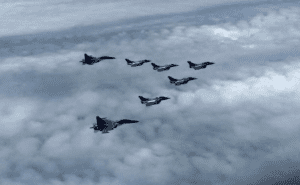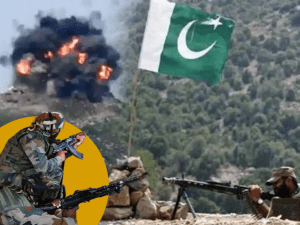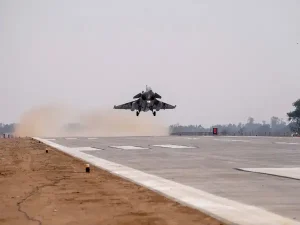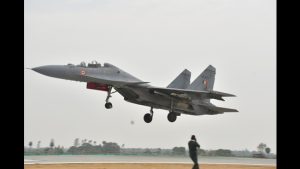New Delhi – The Indian Air Force (IAF) is set to conduct a two-day combat exercise starting Wednesday in the country’s western sector. The announcement comes as tensions between India and Pakistan continue to escalate following the deadly Pahalgam terror attack on April 22 that claimed 26 lives. The IAF to conduct two-day combat exercise will involve numerous aerial assets deployed from multiple airbases across four states bordering Pakistan.
Military officials confirmed that the IAF to conduct two-day combat exercise will feature fighter planes, transport aircraft, airborne warning and control system (AWACS) aircraft, mid-air refuelers, helicopters, and unmanned aerial vehicles. The comprehensive nature of the drills highlights India’s commitment to maintaining combat readiness amid deteriorating regional security conditions.
“IAF is conducting a pre-planned, routine training exercise,” stated an IAF spokesperson, though the timing suggests strategic messaging in the current geopolitical context.

Deployment Details and Exercise Parameters
The IAF to conduct two-day combat exercise will involve assets from multiple airbases across Rajasthan, Gujarat, Haryana, and Uttar Pradesh. Military sources confirmed that India has issued a NOTAM (notice to airmen) regarding airspace restrictions in Rajasthan that extends toward the Pakistan border. These restrictions will be in effect between 3:30 PM on Wednesday and 9:30 PM on Thursday.
Also Read: 11 Mock Drill Locations in Delhi: Essential Guide to Operation Abhyaas
India’s frontline fighter jets, including the Rafale, Su-30 MKI, MiG-29, Mirage-2000, and indigenous Tejas aircraft, will participate in the exercise. A senior defense official, speaking on condition of anonymity, emphasized that “the exercise seeks to test the IAF’s combat readiness” in scenarios resembling potential real-world contingencies.


The decision for the IAF to conduct two-day combat exercise appears strategically timed, occurring precisely as Pakistan continues to violate ceasefire agreements along the Line of Control (LoC) in Jammu and Kashmir.
Rising Indo-Pak Tensions Following Pahalgam Attack
The announcement that the IAF to conduct two-day combat exercise comes amid a dramatic escalation in tensions between India and Pakistan. The April 22 Pahalgam terror strike, which resulted in 26 casualties, has been described as the worst attack on civilians since the 2008 Mumbai terror attacks and reminiscent of the height of terrorism in the region during the 1990s and 2000s.
Pakistan’s military actions have further complicated the situation. On Tuesday, the Pakistan Army fired at Indian posts across eight sectors along the LoC, including Kupwara, Baramulla, Poonch, Rajouri, Mendhar, Naushera, Sunderbani, and Akhnoor. This marked the twelfth consecutive day of ceasefire violations since the Pahalgam attack.


Defense analysts note that while the IAF to conduct two-day combat exercise may have been scheduled previously, its execution at this particular moment serves as a clear demonstration of India’s military preparedness.
Military Posturing from Both Sides
The IAF to conduct two-day combat exercise is not occurring in isolation. Both India and Pakistan have engaged in a series of military drills and demonstrations since the Pahalgam attack. These include missile launches and various other exercises designed to project strength.


Pakistan’s decision to target multiple sectors along the LoC simultaneously represents a significant escalation in its approach. Military observers consider this a deliberate attempt to increase tensions along the de facto border, where Pakistan has deployed reinforcements to strengthen its position.
The Indian Army has responded with what officials describe as “measured but effective” counter-fire. This exchange represents the most extensive cross-border fire since the 2021 ceasefire agreement between the two countries.
Prime Minister’s Response and Military Readiness
During the past four days, Prime Minister Narendra Modi has received multiple security briefings from top officials regarding the operational readiness of the armed forces and the evolving security dynamics in the region. These briefings coincide with the announcement that the IAF to conduct two-day combat exercise in the western sector.
The Prime Minister has granted the military complete operational freedom to respond to the Pahalgam terror attack, emphasizing that the armed forces may choose “the mode, targets, and timing of the response.” This statement echoes the approach taken after previous terror incidents, most notably following the 2019 Pulwama attack that led to the Balakot airstrikes against terrorist camps in Pakistan.
The IAF to conduct two-day combat exercise demonstrates that India maintains a high level of military preparedness even as diplomatic channels remain open.
Enhanced Military Capabilities Since Balakot
Since the 2019 Balakot airstrikes, India has significantly enhanced its offensive capabilities, providing context for the current exercise. The IAF to conduct two-day combat exercise will showcase some of these advanced systems that have been inducted into service over recent years.
Key additions to India’s military arsenal include Rafale fighter jets, S-400 air defense missile systems, the Barak 8 air defense system, the indigenous aircraft carrier INS Vikrant, nuclear-powered ballistic missile submarine INS Arighaat, Prachand light combat helicopters, C-295 tactical transport aircraft, artillery guns, and new assault rifles.


Military experts note that the capability boost, which coincided with the military standoff with China in eastern Ladakh, also includes various unmanned systems, smart air-to-ground weapons, missiles, rockets, precision munitions, tank ammunition, high-tech surveillance systems, and specialist vehicles.
The IAF to conduct two-day combat exercise will likely utilize many of these advanced systems, demonstrating India’s improved operational capabilities.
Regional Security Implications
The decision for the IAF to conduct two-day combat exercise carries significant implications for regional security dynamics. Neighboring countries will closely monitor these drills, particularly as they occur in proximity to the international border with Pakistan.
Security analysts suggest that the exercise serves multiple purposes: testing operational readiness, validating new tactics and systems, and sending a strategic message regarding India’s resolve to protect its territorial integrity. The IAF to conduct two-day combat exercise also demonstrates India’s commitment to responding firmly to cross-border terrorism.
The extensive ceasefire violations along the LoC have raised concerns about the potential for wider conflict. However, military experts believe that the IAF to conduct two-day combat exercise represents a calibrated response that balances deterrence with restraint.
Final Word
As the IAF to conduct two-day combat exercise begins Wednesday, it marks an important moment in India’s security posture amid heightened regional tensions. The exercise demonstrates India’s military preparedness while sending a clear message regarding its capabilities and resolve.
The timing of the decision for the IAF to conduct two-day combat exercise, against the backdrop of ceasefire violations and the aftermath of the Pahalgam attack, highlights the complex security environment in South Asia. While described as “routine” and “pre-planned,” the exercise carries unmistakable strategic significance in the current geopolitical context.
Military officials emphasize that while the IAF to conduct two-day combat exercise represents a demonstration of strength, India remains committed to responsible behavior as a regional power. The exercise reflects India’s defensive preparations rather than offensive intentions, even as it maintains the capability to respond decisively if required.
As both nations continue their military posturing, the international community watches closely, hoping that diplomatic channels will ultimately prevail in reducing tensions between the nuclear-armed neighbors.

